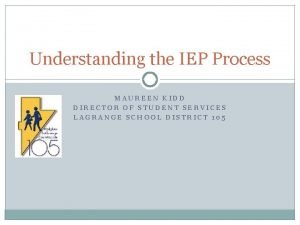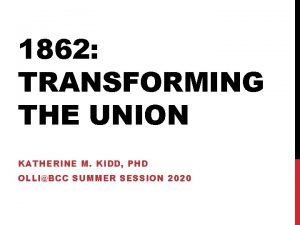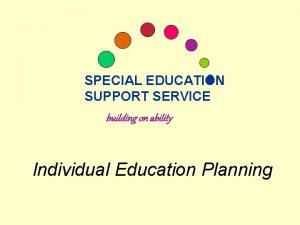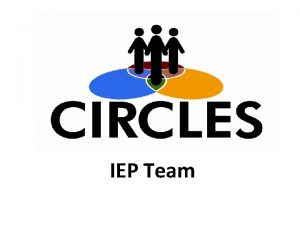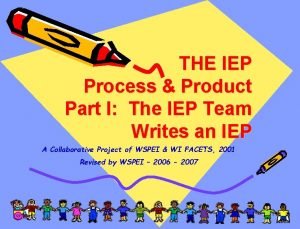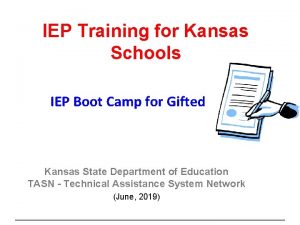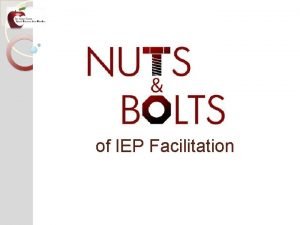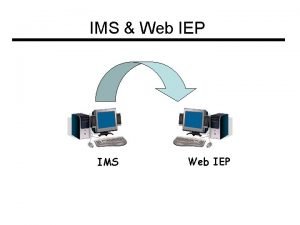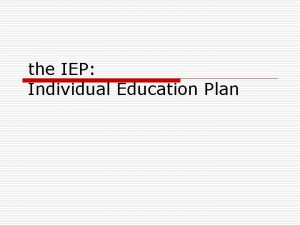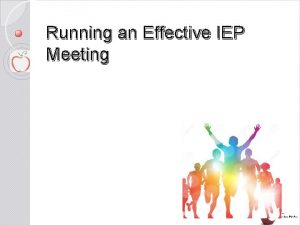Understanding the IEP Process MAUREEN KIDD DIRECTOR OF














- Slides: 14

Understanding the IEP Process MAUREEN KIDD DIRECTOR OF STUDENT SERVICES LAGRANGE SCHOOL DISTRICT 105

Tonight We will… �Define an Individualized Education Plan �Define the Steps the Developing the IEP �Discuss what to expect at an IEP meeting �Provide suggestions on how parents can prepare for an IEP meeting �Answer any questions that you may have

What is an IEP? It stands for Individualized Education Plan. It is a written plan defining the program that is designed to meet the unique needs of one child. The Individuals with Disabilities Education Act (IDEA) requires public school districts to develop an individualized plan for every child who qualifies as having one of the identified thirteen disabilities identified by IDEA as a qualifying condition for special education.

An Overview of the 13 Eligibility Categories �Autism �Orthopedic Impairment �Blindness �Other Health Impaired �Deafness �Specific Learning �Emotional Disturbance Disability �Speech or Language Impairment �Traumatic Brain Injury �Hearing Impairment �Intellectual Disability �Visual Impairment �Developmental Delay

What is the Goal of Special Education? � Special education is a broad term used to by the law to describe specially designed instruction that meets the unique needs of a child who has a disability. These services are provided by the public school system and are free of charge. Services can include instruction in the classroom, at home, in hospitals and private therapy schools and residential facilities. � Special education makes it possible for your child to achieve academic success in the least restrictive environment despite their disability. IDEA entitles all children with learning disabilities to a free appropriate education (FAPE). Examples of "appropriate" programs include: • • • A specific program or class for your child. ����� Access to specialists. ���� Modifications in the educational program such as curriculum and teaching methods.

Five Steps of the IEP Process 1. REFERRAL FOR AN EVALUATION 2. THE EVALUATION 3. DETERMINING A DISABILITY 4. WRITING THE IEP DOCUMENT 5. THE IEP MEETING

Referral for an Evaluation �An IEP referral can be initiated by the school's student study team (SST), but often there is a direct request for a special education evaluation. �The referral can originate from a parent, teacher or other school personnel. The Individual with Disabilities Education Act, (IDEA), mandates that school districts have the responsibility to identify, find and evaluate students who live within their boundaries suspected of having a disability. This is called child find.

The Evaluation � The special education evaluation or assessment provides the IEP team information that will be used to determine if your child has one of the 13 types of eligible disabilities defined by IDEA and therefore qualifies them for special education services. � If your child’s primary language is not English, the evaluation must be administered in their native language or through a bilingual specialist or interpreter. � The assessment will measure areas of cognition, academics and language skills along with social, emotional, developmental and medical findings. � A special education evaluation should always include student records, observations, work samples, state and district tests, standardized tests and interviews. � If your student is found eligible for special education services, this evaluation process will be repeated every three years to determine continued eligibility.

Determining Eligibility �After the assessment is complete, an eligibility IEP meeting is held. Here, the team discusses the results of the evaluation and determines if your child has met the criteria for special education. �There are three questions that must be answered: Does the student have one of the 13 disabilities outlined? Does it impact on their educational performance? Does the student require special education services to make growth and progress towards acquiring grade-level expectations?

Writing the IEP � An individualized education program (IEP) will be written at the eligibility meeting if your child has been found to be eligible for special education services. � The IEP should ensure your child has access to a free appropriate education and should consider your child’s strengths, parent concerns, assessment results and areas of need related to academic and developmental areas. The individualized education program is a written, legal document that must include: � � � � � Your child’s present level of functioning Strengths, weaknesses, abilities and educational needs Area(s)of eligibility (based on the 13 categories named in IDEA) Annual goals and objectives Required services Program placement Accommodations and level of participation in assessments Transition plan, If necessary Extended School Year and Transportation needs

The IEP Meeting �If this is the first IEP meeting, this will occur at the evaluation and eligibility meeting. If not, it will occur on the anniversary of that initial IEP meeting. �You will receive a written invitation in the mail to invite you to the meeting. This meeting will be scheduled during a mutually agreed-upon time. Those invited to the meeting will include: Special Education Teacher; a general education teacher; the school psychologist and any other specialists; a school administrator; the parent; the Child (if appropriate)

The IEP Meeting �The meeting will follow the following agenda: Introductions Signing the Conference Summary Report Receiving your Procedural Safeguards Explaining the purpose of the meeting Including Parental concerns and questions Discussing student strengths Reviewing Present Levels of Performance Discussing projected goals and objectives tied to CCSS Discussing needed accommodations and supports Discussing assessment needs Discussing special education instruction and related service minutes. Discussing placement recommendations Discussing Extended School Year and Transportation

�Have confidence that your team is What can you do to prepare for the IEP meeting? here to help your student succeed in school. �Share concerns �Generate a list of questions �Bring a file of important documents �Ask questions if something is unclear �Inform the case manager if you are bringing others to the IEP meeting

Questions?
